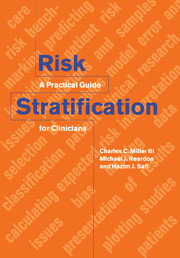2 - Collecting data
Published online by Cambridge University Press: 22 March 2010
Summary
In this chapter we will discuss the process and pitfalls of collecting data for risk analysis and stratification. Accurate risk predictions can only be based upon scrupulously collected, high-quality data. Because of the importance of good data as the cornerstone of risk modeling, considerable forethought and effort are warranted in the process of data collection. Many investigators, upon initially pondering a database project, are set upon by an urge to collect (or more likely to arrange for someone else to collect) every remotely relevant data point that comes to mind. We advocate a hearty resistance to this urge, and in fact recommend a deliberate orientation toward collecting as few data elements as possible, rather than as many as possible. The goal of data collection and risk modeling should be to identify and collect the smallest amount of data required to provide good prediction and thereby to answer the question at hand. Since this recommendation goes against every investigator's native intellectual curiosity, we provide the following justification.
Some general comments
Data are expensive and time consuming to collect. This is always true, and shortcuts such as conscripting exhausted residents to collect data or handing out huge blank data collection forms to floor nurses are false economies. Residents rotate on and off service, and have different levels of experience and maturity of judgment, as well as different levels of interest in projects of this type. Surgical residents want to operate, because that is how they accrue credit toward board certification.
- Type
- Chapter
- Information
- Risk StratificationA Practical Guide for Clinicians, pp. 30 - 49Publisher: Cambridge University PressPrint publication year: 2001
- 2
- Cited by



